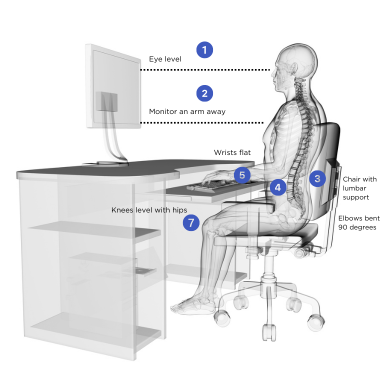In today’s fast-paced world, where remote work is becoming increasingly prevalent, creating an ergonomic workstation has never been more crucial. Whether you’re working from home or in an office setting, your workstation’s setup plays a significant role in your overall health, productivity, and well-being. From proper posture to selecting the right equipment, there are several key factors to consider. In this comprehensive guide, we’ll explore the top ergonomic tips for setting up an office workstation and discuss the essential products to invest in
Understanding Ergonomics:
Before diving into workstation setup tips, it’s essential to understand the concept of ergonomics. Ergonomics is the science of designing equipment and workplaces to maximize productivity while reducing discomfort and the risk of injury. A well-designed ergonomic workstation takes into account factors such as posture, lighting, equipment placement, and movement.
Top Ergonomic Tips for Workstation Setup:
- Chair Selection and Adjustment: Invest in a high-quality ergonomic chair that provides adequate lumbar support, adjustable armrests, and seat height. Adjust the chair’s height so that your feet rest flat on the floor, and your knees are level with your hips. Maintain a slight recline to reduce pressure on the spine.
- Desk Setup: Choose a desk that allows for proper ergonomic positioning. The desk should be at a height where your elbows are at a 90-degree angle when typing, and your wrists are straight. Ensure there is enough space to accommodate your computer monitor, keyboard, mouse, and other essential items.
- Monitor Placement: Position your monitor directly in front of you at eye level, about an arm’s length away. Adjust the monitor height so that the top of the screen is at or slightly below eye level to prevent neck strain. Consider using a monitor stand or adjustable arm to achieve the optimal position.
- Keyboard and Mouse: Use an ergonomic keyboard and mouse to minimize strain on your wrists and hands. Keep the keyboard and mouse close to your body, with your elbows comfortably by your sides. Use wrist rests to support your wrists and maintain a neutral typing position.
- Proper Lighting: Ensure adequate lighting in your workspace to reduce eye strain and fatigue. Position your desk lamp to illuminate the workspace evenly, avoiding glare on the monitor screen. Consider using natural light whenever possible and adjust window blinds to reduce glare.
- Foot Support: Use a footrest if your feet do not comfortably reach the floor when seated. This helps promote proper posture and circulation by relieving pressure on the legs and lower back.
- Organizational Tools: Keep your workstation organized and clutter-free to minimize distractions and improve productivity. Use cable management solutions to keep cords and cables neatly arranged and out of the way.
- Regular Breaks and Movement: Take regular breaks to stretch and move around to prevent stiffness and fatigue. Incorporate stretching exercises into your daily routine to relieve muscle tension and improve circulation. If you have a sit–to-stand desk, stand up and sit down in a cycle every 30 minutes.

Essential Products for an Ergonomic Workstation:
- Ergonomic Chair: A supportive chair with adjustable features is essential for maintaining proper posture and reducing the risk of back pain.
- Adjustable Desk: Invest in a height-adjustable desk that allows you to alternate between sitting and standing throughout the day. This promotes movement and helps prevent prolonged sitting.
- Monitor Stand or Arm: A monitor stand or adjustable arm allows you to position your monitor at the correct height and distance, reducing strain on your neck and eyes.
- Ergonomic Keyboard and Mouse: Look for ergonomic keyboards and mouse that promote a natural hand position and reduce strain on the wrists and fingers.
- Footrest: A footrest provides support and promotes proper posture by ensuring your feet are comfortably positioned while seated.
- Desk Lamp: Choose a desk lamp with adjustable brightness and direction to provide adequate lighting without causing glare on your monitor screen.
- Cable Management Solutions: Keep cords and cables organized and out of the way with cable management solutions such as cable trays, clips, and sleeves.
What to Look for in Ergonomic Products:
- Adjustability: Opt for products that offer a range of adjustment options to accommodate different body types and preferences.
- Comfort: Choose products that prioritize comfort and support to reduce strain and discomfort during prolonged use.
- Quality: Invest in high-quality products that are durable and built to last, ensuring long-term comfort and performance.
- Ergonomic Design: Look for products specifically designed with ergonomic principles in mind, such as curved keyboard layouts and contoured chair designs.
- User Reviews: Research products thoroughly and read user reviews to gauge satisfaction and performance before making a purchase.
In conclusion, creating an ergonomic workstation is essential for promoting health, comfort, and productivity in both home and office settings. By following these top ergonomic tips and investing in the right products, you can design a workstation that supports your well-being and enhances your work experience. Prioritize comfort, adjustability, and ergonomic design when selecting workstation equipment, and don’t hesitate to seek professional guidance if needed. With the right setup, you can optimize your workspace and enjoy the benefits of improved posture, reduced strain, and increased productivity.

